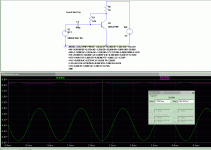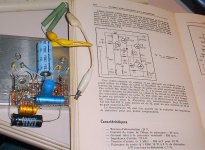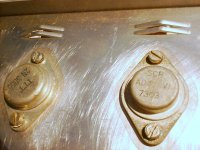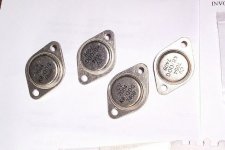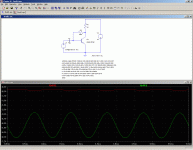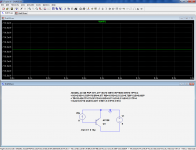Seems inordinately complicated, all you really need is bf, Vje, Vaf possibly, Rb and Re, and quite important, Isc.
OC71! The one where f ∝ is 15 kHz.
I cobbled up one for OC76, probably close enough PNP(Is=1e-10 bf=50 Vje=0.15 Vaf=10 Cje=5p Cjc=2.5p Tf=3n Eg=.67 Rb=10 Re=1 Isc=10u)
OC71! The one where f ∝ is 15 kHz.
I cobbled up one for OC76, probably close enough PNP(Is=1e-10 bf=50 Vje=0.15 Vaf=10 Cje=5p Cjc=2.5p Tf=3n Eg=.67 Rb=10 Re=1 Isc=10u)
Member
Joined 2009
Paid Member
OC71! The one where f ∝ is 15 kHz.
I cobbled up one for OC76, probably close enough PNP(Is=1e-10 bf=50 Vje=0.15 Vaf=10 Cje=5p Cjc=2.5p Tf=3n Eg=.67 Rb=10 Re=1 Isc=10u)
I accidentally bought 15 of them off ebay. Fortunately, I can't hear anything much above 13kHz...
How did the OC76 differ from OC71 from a designers standpoint ?
I was wrong! 15 kHz is OC70!
OC71, 75mW, 11 kHz, 30V, Hfe 30 - 75 @ 3mA, "audio amplifiers", cost 12p
OC76, 75mW, 350 kHz, 32V, Hfe 45 (minimum) @ 10mA, "G.P. and switching", cost 15p

Wow 3 shillings in old money. Does look like "higher spec" though must be honest.
A while ago I was looking for any available OC70/71 on the net, couldn't find any. Though I wasn't looking that hard. In case anybody wanted one, think they've all been bought.
OC71, 75mW, 11 kHz, 30V, Hfe 30 - 75 @ 3mA, "audio amplifiers", cost 12p
OC76, 75mW, 350 kHz, 32V, Hfe 45 (minimum) @ 10mA, "G.P. and switching", cost 15p
Wow 3 shillings in old money. Does look like "higher spec" though must be honest.
A while ago I was looking for any available OC70/71 on the net, couldn't find any. Though I wasn't looking that hard. In case anybody wanted one, think they've all been bought.
I've tried various values for a PNP Germanium Transistor SPICE Model and found that in order to reduce Vbe to an acceptable level (approx. 200mV) reduces the hfe (gain) to negligible response with BF (Beta Forward) at nominal 50-100 value in a working SPICE CAD preamplifier circuit. I recently purchased OrCAD Suite with PSpice 10.5 and successfully installed it onto my Toshiba Satellite C655D with Windows Home Premium (using Windows XP SP2 Compatibility Install). I also have Licensed AdLabPlus that has a very powerful Semiconductor Modeler. Also, I have a copy of bjt.xls that requires Microsoft Office Excel with Macro Capability. I have my own Licensed Microsoft Office Professional for that. Of the 3 mentioned Modelers (PSpice. AdLabPlus and bjt.xls) I definitely prefer OrCAD, since it is most reliable. Although the Semiconductor Modeler in AdLabPlus is very good too. bjt.xls is somewhat more complicated. My first attempt at a PNP Germanium Xstr SPICE Model was the AC128 and operates successfully in the preamp circuit although it does not emulate the actual Transistor Specifications. I have found that if the Model or Subcircuit is designed with close tolerance original values it will not function in simulation as desired in an actual preamp circuit. I am continually revising the PNP Germanium Xstr SPICE Model until I get satisfactory results both with parameter values and in actual Oscilloscope Simulation in a working preamplifier circuit. I have hope that with OrCAD PSpice Application I can do so in the near (or at least distant) future...
ONCE AGAIN HERE IS THE ONE THAT FUNCTIONS IN SIMULATION:
.MODEL GEBJTPNP PNP(IS=1.208F BF=50.000 NF=1.000 VAF=102.207
+IKF=9.981M ISE=0.435F NE=1.200 BR=10.000 NR=1.000 VAR=20.000
+IKR=1.248M ISC=1.208F NC=1.200 RB=173.312 IRB=5.000U RBM=43.328
+RE=20.000 RC=60.000 CJE=6.000P VJE=0.400 MJE=0.400 TF=0.150U
+XTF=9.996 VTF=2.000 ITF=9.983M PTF=1.000 CJC=3.750P
+VJC=0.600 MJC=0.330 XCJC=0.650 TR=2.865U
+CJS=0.0 VJS=0.700 MJS=0.500 XTB=1.000 EG=0.670
+XTI=4.000 KF=5.000F AF=1.000 FC=0.750)
.END
Most obvious are: IS, ISE and ISC in femto values. Changing these same to pico or even nano values (an increase of 1000 each time!) brings the Vbe to a satisfactory level, yet reduces the gain in simulation too much. Reducing VAF and VAR would probably be proper too. These and other factors are what are unique about Germanium Xstrs. The incredible sensitivity of the device itself is dependent upon same. Capacitance values too in this Model need adjustment...onward...I go.
ONCE AGAIN HERE IS THE ONE THAT FUNCTIONS IN SIMULATION:
.MODEL GEBJTPNP PNP(IS=1.208F BF=50.000 NF=1.000 VAF=102.207
+IKF=9.981M ISE=0.435F NE=1.200 BR=10.000 NR=1.000 VAR=20.000
+IKR=1.248M ISC=1.208F NC=1.200 RB=173.312 IRB=5.000U RBM=43.328
+RE=20.000 RC=60.000 CJE=6.000P VJE=0.400 MJE=0.400 TF=0.150U
+XTF=9.996 VTF=2.000 ITF=9.983M PTF=1.000 CJC=3.750P
+VJC=0.600 MJC=0.330 XCJC=0.650 TR=2.865U
+CJS=0.0 VJS=0.700 MJS=0.500 XTB=1.000 EG=0.670
+XTI=4.000 KF=5.000F AF=1.000 FC=0.750)
.END
Most obvious are: IS, ISE and ISC in femto values. Changing these same to pico or even nano values (an increase of 1000 each time!) brings the Vbe to a satisfactory level, yet reduces the gain in simulation too much. Reducing VAF and VAR would probably be proper too. These and other factors are what are unique about Germanium Xstrs. The incredible sensitivity of the device itself is dependent upon same. Capacitance values too in this Model need adjustment...onward...I go.
Curious to know what are your motivations for wanting to design with germanium?
I've had an idea of wanting to build a fully complementary output stage using only vintage components and mixing early silicon with germanium, a totem pole output with an early '3055 and an OC35. (just for the fun of it). Anyone tried this?
Henry
I've had an idea of wanting to build a fully complementary output stage using only vintage components and mixing early silicon with germanium, a totem pole output with an early '3055 and an OC35. (just for the fun of it). Anyone tried this?
Henry
My motivation is mainly to optimize the repair service of old stuff like this:Curious to know what are your motivations for wanting to design with germanium?
I've had an idea of wanting to build a fully complementary output stage using only vintage components and mixing early silicon with germanium, a totem pole output with an early '3055 and an OC35. (just for the fun of it). Anyone tried this?
Henry
http://www.diyaudio.com/forums/soli...id-state-audio-amplifier-components-want.html
http://www.diyaudio.com/forums/parts/167680-vintage-transistors.html
If one is able to investigate/evaluate such old circuits with help of CAD software, performed repair service is much more better.
In this case also this thread is of interest:
http://www.diyaudio.com/forums/solid-state/151253-diy-curve-tracer-pc.html
I tried it, and japanese amplifiers of the early seventies also did it.Curious to know what are your motivations for wanting to design with germanium?
I've had an idea of wanting to build a fully complementary output stage using only vintage components and mixing early silicon with germanium, a totem pole output with an early '3055 and an OC35. (just for the fun of it). Anyone tried this?
Henry
Here is an example, based on a AD161/AD162 application circuit.
The AD161 is replaced by a 2N3055, and the the AD162 by a AD150.
The thermistor, etc, is replaced by a novel class B controller
Attachments
Very intersting. Basicly similar approach I have discover by an NAD model. Instead a married silicon/germanium pair there is in use a BjT/MOSFET pair in their PP power buffer stage - go to post #9 aboutI tried it, and japanese amplifiers of the early seventies also did it.
Here is an example, based on a AD161/AD162 application circuit.
The AD161 is replaced by a 2N3055, and the the AD162 by a AD150.
The thermistor, etc, is replaced by a novel class B controller
http://www.diyaudio.com/forums/soli...l-kind-thd-mosfet-bjt-new-me.html#post2140251 for the schematic, and for more info how it sound have a look about
http://www.diyaudio.com/forums/solid-state/160318-nad-310-need-some-info.html
What is the exactly model of the power amp, where you have found the 2N3055/AD150 and what is the title of the amplifier book showed in the first picture?
The amplifier has a 3300µF output capacitor.
The schematic is based on a Siemens application note, the 2N3055 and AD150 were bought in the early seventies (!), and the book is "Schémas d'amplificateurs basse fréquence à transistors" by René Besson, 4th edition, 1972 (No ISBN!).
http://www.amazon.fr/Schémas-damplificateurs-basse-fréquence-transistors/dp/B0000DYCNL
The schematic is based on a Siemens application note, the 2N3055 and AD150 were bought in the early seventies (!), and the book is "Schémas d'amplificateurs basse fréquence à transistors" by René Besson, 4th edition, 1972 (No ISBN!).
http://www.amazon.fr/Schémas-damplificateurs-basse-fréquence-transistors/dp/B0000DYCNL
Very interesting! Very like the kind of thing we used to mess about with in the old days. I once had a stereo Heathkit record player with virtually identical amp design to that. The above was pretty typical for its time.
The challenge! I am currently trying to put together a p-p using CV7084, the military version of OC35. With a transformer phase-splitter, yet. 'Cause transformers were involved quite often in the early days.
Curious to know what are your motivations for wanting to design with germanium?
The challenge! I am currently trying to put together a p-p using CV7084, the military version of OC35. With a transformer phase-splitter, yet. 'Cause transformers were involved quite often in the early days.
The incredible sensitivity of the device itself is dependent upon same.
Very interesting, I don't remember germaniums being "incredibly sensitive", for this and several other reasons (like for example can't be much hotter than a freshly made cup of tea else they're destroyed) made us change over to silicons as soon as poss.
ckeck out post #39 and #40 aboutVery interesting! Very like the kind of thing we used to mess about with in the old days. I once had a stereo Heathkit record player with virtually identical amp design to that. The above was pretty typical for its time.
The challenge! I am currently trying to put together a p-p using CV7084, the military version of OC35. With a transformer phase-splitter, yet. 'Cause transformers were involved quite often in the early days.
http://www.diyaudio.com/forums/parts/167680-vintage-transistors.html
for a schematic equipped with OC35
Attachments
My interest in Germanium is purely for Audio...The 2 Transistor Electric Guitar Fuzz Box. I tried the modified version of my model and it works.
.MODEL GEBJTPNP PNP(IS=120.8N BF=85.000 NF=1.000 VAF=102.207
+IKF=9.981M ISE=0.435N NE=1.200 BR=20.000 NR=1.000 VAR=20.000
+IKR=1.248M ISC=120.8N NC=1.200 RB=173.312 IRB=5.000U RBM=43.328
+RE=20.000 RC=60.000 CJE=6.000P VJE=0.400 MJE=0.400 TF=0.150U
+XTF=9.996 VTF=2.000 ITF=9.983M PTF=1.000 CJC=3.750P
+VJC=0.600 MJC=0.330 XCJC=0.650 TR=2.865U
+CJS=0.0 VJS=0.700 MJS=0.500 XTB=1.000 EG=0.670
+XTI=4.000 KF=5.000F AF=1.000 FC=0.750)
.END
.MODEL GEBJTPNP PNP(IS=120.8N BF=85.000 NF=1.000 VAF=102.207
+IKF=9.981M ISE=0.435N NE=1.200 BR=20.000 NR=1.000 VAR=20.000
+IKR=1.248M ISC=120.8N NC=1.200 RB=173.312 IRB=5.000U RBM=43.328
+RE=20.000 RC=60.000 CJE=6.000P VJE=0.400 MJE=0.400 TF=0.150U
+XTF=9.996 VTF=2.000 ITF=9.983M PTF=1.000 CJC=3.750P
+VJC=0.600 MJC=0.330 XCJC=0.650 TR=2.865U
+CJS=0.0 VJS=0.700 MJS=0.500 XTB=1.000 EG=0.670
+XTI=4.000 KF=5.000F AF=1.000 FC=0.750)
.END
ckeck out post #39 and #40 about
http://www.diyaudio.com/forums/parts/167680-vintage-transistors.html
for a schematic equipped with OC35
That's the kind of thing yes.
I discarded my Orcad 10.xx ... it may have been unauthorized ... I only use approved commercial software/freeware ...
Found this online and it works in TINA 10 Basic Plus Simulation ...
.MODEL AC128 PNP(IS=1.41F ISC=0 ISE=0 IKF=80M IKR=0 ITF=0.4
+ NC=2 NE=1.5 BF=70 BR=4.977 RB=10 RC=2.5 CJC=9.728P CJE=8.063P
+ TR=33.42N TF=179.3P FC=0.5 EG=0.67 VJC=0.2 VJE=0.2 VTF=4
+ MJC=0.5776 MJE=0.3677 XTB=1.5 XTF=6 XTI=3)
.END
Found this online and it works in TINA 10 Basic Plus Simulation ...
.MODEL AC128 PNP(IS=1.41F ISC=0 ISE=0 IKF=80M IKR=0 ITF=0.4
+ NC=2 NE=1.5 BF=70 BR=4.977 RB=10 RC=2.5 CJC=9.728P CJE=8.063P
+ TR=33.42N TF=179.3P FC=0.5 EG=0.67 VJC=0.2 VJE=0.2 VTF=4
+ MJC=0.5776 MJE=0.3677 XTB=1.5 XTF=6 XTI=3)
.END
- Status
- Not open for further replies.
- Home
- Amplifiers
- Solid State
- AC128 PNP Germanium Transistor Spice Model (Rare!)
